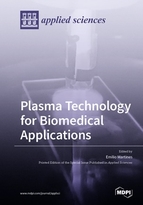Plasma Technology for Biomedical Applications
A special issue of Applied Sciences (ISSN 2076-3417). This special issue belongs to the section "Applied Biosciences and Bioengineering".
Deadline for manuscript submissions: closed (31 July 2019) | Viewed by 48281
Special Issue Editor
Interests: plasma medicine; nuclear fusion; low temperature plasmas; plasma physics; plasma technology
Special Issues, Collections and Topics in MDPI journals
Special Issue Information
Dear Colleagues,
I invite you to contribute to a Special Issue of the journal Applied Sciences, “Plasma Technology for Biomedical Applications”, which aims to present recent developments in the field of the use of ionized gases in biology and medicine.
The use of plasmas for biomedical applications in encountering a growing interest, especially in the framework of so-called “plasma medicine”, which aims at exploiting the action of low-power, atmospheric pressure plasmas for therapeutic purposes. Several applications have already reached the stage of clinical trials, while others are on their way, a large set of different plasma sources able to work at atmospheric pressure with low dissipated power have been created, and some of them are already certified as medical devices. From the scientific viewpoint, action mechanisms for the interaction of plasmas with cells, tissues and pathogens are being elucidated, although this is a slower process which still requires great efforts. Furthermore, the indirect action through the use of plasma-treated liquids is also being explored, presenting promising possibilities. The use of plasmas for proper functionalization of materials to be used in medical practice is also a field where constant advances are being made. Finally, one should mention the possibility of plasma-cell interactions not directly related to a therapeutic action of the plasma, but of great importance for facilitating other therapeutic approaches, such as plasma-mediated gene transfection and drug penetration.
I thus invite you to submit your research on these topics, in the form of original research papers, mini-reviews and perspective articles.
Dr. Emilio Martines
Guest Editor
Manuscript Submission Information
Manuscripts should be submitted online at www.mdpi.com by registering and logging in to this website. Once you are registered, click here to go to the submission form. Manuscripts can be submitted until the deadline. All submissions that pass pre-check are peer-reviewed. Accepted papers will be published continuously in the journal (as soon as accepted) and will be listed together on the special issue website. Research articles, review articles as well as short communications are invited. For planned papers, a title and short abstract (about 100 words) can be sent to the Editorial Office for announcement on this website.
Submitted manuscripts should not have been published previously, nor be under consideration for publication elsewhere (except conference proceedings papers). All manuscripts are thoroughly refereed through a single-blind peer-review process. A guide for authors and other relevant information for submission of manuscripts is available on the Instructions for Authors page. Applied Sciences is an international peer-reviewed open access semimonthly journal published by MDPI.
Please visit the Instructions for Authors page before submitting a manuscript. The Article Processing Charge (APC) for publication in this open access journal is 2400 CHF (Swiss Francs). Submitted papers should be well formatted and use good English. Authors may use MDPI's English editing service prior to publication or during author revisions.
Keywords
- plasma medicine
- biomedical plasma applications
- plasma sources for biomedical applications
- plasma disinfection
- plasma in cancer treatment
- plasma-stimulated wound healing
- plasma sterilization
- plasma activated water
- plasma activated medium






